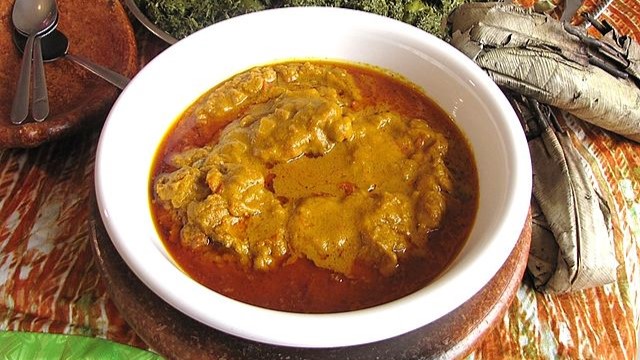By Jonas Loubin
The scent of palm oil drifts from a pot balanced over glowing charcoal. Outside, rain presses on the corrugated roofs of Kinshasa’s open-air markets. In a city where sound is constant—car horns, street calls, and the clatter of metal spoons against enamel bowls—food remains a point of calm, a slow rhythm carried from kitchen to table. Across the Democratic Republic of the Congo, cuisine is as layered as the country’s landscapes: rainforest, savannah, river delta. Each dish is a record of migration, trade, and memory.
Staple ingredients anchor the Congolese table—cassava, plantains, maize, rice—simple in form but infinitely adaptable. From these foundations emerge meals that speak of both necessity and artistry, shaped by the terrain and the seasons.
Moambe Chicken: The Signature Dish
At the core of the national palate lies moambe chicken, a dish often regarded as the country’s culinary emblem. Chicken is simmered in a sauce made from palm nuts—thick, brick-red, and faintly sweet—its richness offset by a savory depth. The palm fruit, abundant in much of the DRC, is not just an ingredient but a staple that shapes the flavor profile of daily life.
Traditionally, the dish is served with fufu, a starchy accompaniment made from pounded cassava, maize, or plantains. Fufu is more than a side; it is a dining tool, pressed between fingers to scoop sauce and meat from a shared plate. Variations of moambe replace chicken with fish or beef, but the palm nut base remains constant, binding the dish to its origins.
Fufu: A Cultural Constant
Fufu itself occupies a place of quiet authority in Congolese cooking. Prepared by pounding boiled starches into a smooth, elastic mound, it holds little flavor alone but serves as the bridge between sauces and stews. Its tactile nature encourages communal eating, reinforcing the idea that a meal is both sustenance and social contract.
Liboke: Cooking in Leaf and Flame
In river towns and village kitchens, liboke offers a different kind of tradition—fish, chicken, or meat marinated in spices, wrapped in banana leaves, and steamed or grilled. The leaves lock in steam, allowing herbs and smoke to infuse the food. Liboke de poisson, often prepared with tilapia or catfish from the Congo River, carries the layered taste of the fire, the leaf, and the water it came from.
Saka-Saka and Pondu: The Cassava’s Second Life
Cassava, beyond its starchy roots, gives its leaves to saka-saka, a leafy stew simmered with palm oil, garlic, onions, and ground peanuts for a nutty undertone. Served with rice or fufu, its texture is soft, almost creamy, with a vegetal depth. Pondu, a close relative, stews the same leaves with tomatoes, onions, and sometimes fish, yielding a thicker, heartier dish that speaks of rainy-season kitchens.
Makemba: Sweetness from the Market
Among the city’s street stalls, plantains are transformed into makemba—fried or boiled until caramelized outside and tender within. Often served alongside grilled meat or fish, they balance savory spice with a mellow sweetness, a reminder that Congolese cooking celebrates contrast as much as comfort.
Thomson’s Beans: An Adopted Classic
Thomson’s beans, named for missionaries who helped introduce them, have become a quiet staple. Slow-cooked with onions, garlic, and occasionally tomatoes, they form a humble but satisfying dish, paired most often with rice or fufu.
From the slow-simmered depth of moambe chicken to the leaf-wrapped delicacy of liboke, Congolese cuisine carries the imprint of the land. Each plate is an act of continuity, sustaining communities through flavor, ritual, and the shared act of eating. Here, food is more than nourishment—it is the living memory of the Congo itself.
Sources
- White, Bob W. Rumba Rules: The Politics of Dance Music in Mobutu’s Zaire. Duke University Press, 2008.
- De Boeck, Filip, and Marie-Françoise Plissart. Kinshasa: Tales of the Invisible City. Ludion, 2004.
- Nzongola-Ntalaja, Georges. The Congo: From Leopold to Kabila: A People’s History. Zed Books, 2002.


